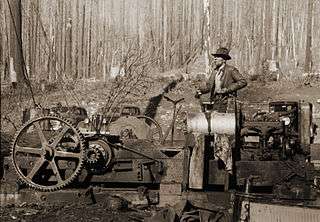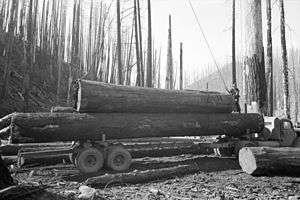Gyppo logger
A gyppo or gypo logger is a logger who runs or works for a small-scale logging operation that is independent from an established sawmill or lumber company. The gyppo system is one of two main patterns of historical organization of logging labor in the Pacific Northwest United States, the other being the "company logger".

Gyppo loggers were originally condemned by the Industrial Workers of the World (IWW) as strikebreakers. After the founding of a government-sponsored company union, the Loyal Legion of Loggers and Lumbermen, weakened the influence of the IWW on the logging industry, attitudes towards gyppos changed, and they came to be seen as a normal component of the timber business in a less ideologically charged context.
Etymology and context

The term "gyppo" is specific to the Pacific Northwest region of the United States and Canada. Its etymology is certainly unrecoverable at this date. According to E.B. Mittelman, it "may be a derivation from the Greek word, signifying vulture,[1] or may simply be a derivation or corruption of the word gypsy." In either case, notes Mittelman, "it has something of the cunning or predacious in it."[2] The Greek etymology is lent some plausibility by the fact that big lumber companies tried to use workers of Greek ethnicity, who would not cooperate, to break a strike organized by the IWW in Everett, Washington in 1917.[3]
The term "gyppo" was commonly prepended to form nicknames among loggers, e.g. "Gyppo Jake".[4] The word was introduced by the Industrial Workers of the World (IWW) to disparage[5] strikebreakers and other loggers who thwarted their organizing efforts.[2] The IWW currently uses the term to refer to "Any piece-work system; a job where the worker is paid by the volume they produce, rather than by their time."[6] Mittelman quotes an editorial from the Industrial Worker on the subject:
At present the master class of capitalists call it 'contract labor,' 'piece work,' and other fancy names...For us, the proletarians, it is 'gyppoing' and it means all that the name connotes. The gyppo is a man who 'gyps' his fellow workers and finally himself, out of the fruits of all our organized victories in the class war."[2]
The term lost most of its derisive connotation after the decline of the IWW's influence in the lumber industry.[7]
The gyppo system

The "gyppo logger" is generally considered the opposite of the "company logger", who is employed by a lumber company or lumber mill at an hourly or daily wage and generally belongs to a labor union. Gyppos, on the other hand, work for themselves, run economically marginal operations,[8] and employ a small crew on a fixed-price basis,[9] although they occasionally work for mills on a flat-rate, contract,[10] or piecework basis.[2]
The IWW first introduced the term gyppo during the unsuccessful 1917–18 Pacific Northwest loggers' strike, which called for an eight-hour day for loggers, although undoubtedly gyppo loggers existed before this date. Because the strike was unsuccessful, after the loggers returned to work they called a slowdown. This tactic was so effective that in response the company owners instituted piecework or flat-rate pay scales. Pine timber in the Pacific Northwest is comparatively small and much of it is on government-owned land (disallowing the use of railways to transport logs); these conditions facilitate logging with small crews and portable machinery.[2]
Technological developments after World War II made gyppo logging even more economically rewarding, especially the invention of gasoline-powered chainsaws, which were light enough to be used by a single person, and the use of diesel engines to power "donkeys" that had previously been powered by steam. Gyppos of this era also took advantage of the increased affordability of light industrial equipment, such as trucks and Caterpillar tractors, and typically employed family labor in order to keep their operations economically viable.[12]
According to William Robbins, writing on the postwar timber boom in the Coos Bay region of Oregon:
The immediate postwar years in southwestern Oregon were the heyday of the storied gyppo logging and sawmill operator—the hardy individual who worked on marginal capital, usually through subcontracts with a major company or broker, and whose equipment was invariably pieced together with baling wire.
By the mid-1950s, over-extraction of timber had begun to reduce the economic incentive to practice gyppo logging.[11] By the 1970s, environmental regulation and other economic changes in the logging industry had driven many gyppo loggers out of business.[9] By the early 21st century, gyppo loggers were described as "an endangered species."[13]
See also
- Sometimes a Great Notion, a 1964 novel by Ken Kesey about a family of gyppo loggers in Oregon
References
- γύπας (gypas)
- E.B. Mittleman (December 1923). "The Gyppo System". Journal of Political Economy. 31 (6): 840–851. doi:10.1086/253566. JSTOR 1822448.
- "Lumber Strike Still Spreading". Industrial Worker. July 28, 1917. p. 1. Retrieved August 29, 2012.
- Henry S. Kernan (July 1945). "Idaho Lumberjack Nicknames". California Folklore Quarterly. 4 (3): 239–243. JSTOR 1495817.
- Randall V. Mills (May 1950). "Oregon Speechways". American Speech. 25 (2): 81–90. doi:10.2307/453898. JSTOR 453898.
- "IWW Union Dictionary". Industrial Workers of the World. Archived from the original on October 9, 2011. Retrieved August 29, 2012.
- John C. Hughes; Ryan Teague Beckwith (30 September 2005). On the Harbor: From Black Friday to Nirvana. Stephens Press, LLC. p. 16. ISBN 978-1-932173-50-5. Retrieved 29 August 2012.
- Vincent Ostrom (June 1953). "State Administration of Natural Resources in the West". The American Political Science Review. 47 (2): 478–493. doi:10.2307/1952034. JSTOR 1952034.
- David H. Williamson (January 1977). "Some Effects of Social and Economic Changes on Gyppo Loggers". Anthropological Quarterly. 50 (1): 31–38. doi:10.2307/3317385. JSTOR 3317385.
- Norman S. Hayner (April 1945). "Taming the Lumberjack". American Sociological Review. 10 (2): 217–225. doi:10.2307/2085640. JSTOR 2085640.
- Robert E. Walls (Fall 2002). "Lady loggers and gyppo wives: women and Northwest logging". Oregon Historical Quarterly. 103 (3): 362ff.
- John Vaillant (3 January 2006). The Golden Spruce: A True Story of Myth, Madness and Greed. Random House. p. 36. ISBN 978-0-676-97646-5. Retrieved 29 August 2012.
Further reading
- Margaret Elley Felt; Robert E. Walls (1 February 2002). Gyppo Logger. University of Washington Press. ISBN 978-0-295-98166-6. Retrieved 29 August 2012.
- Stewart Hall Holbrook (1956). Holy old mackinaw: a natural history of the American lumber- jack. Macmillan. Retrieved 29 August 2012.
- David H. Williamson (1976). Give 'er Snoose: A Study of Kin and Work Among Gyppo Loggers of the Pacific Northwest. Catholic University of America. Retrieved 29 August 2012.
- The Lumber Industry and its Workers (3rd ed.). Chicago: Industrial Workers of the World. 1922. Retrieved August 29, 2012.